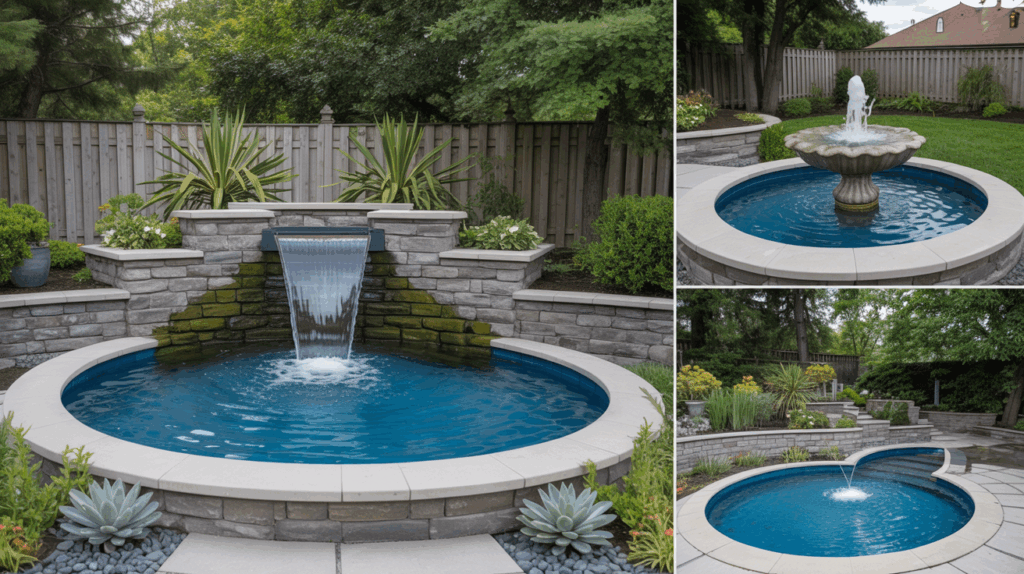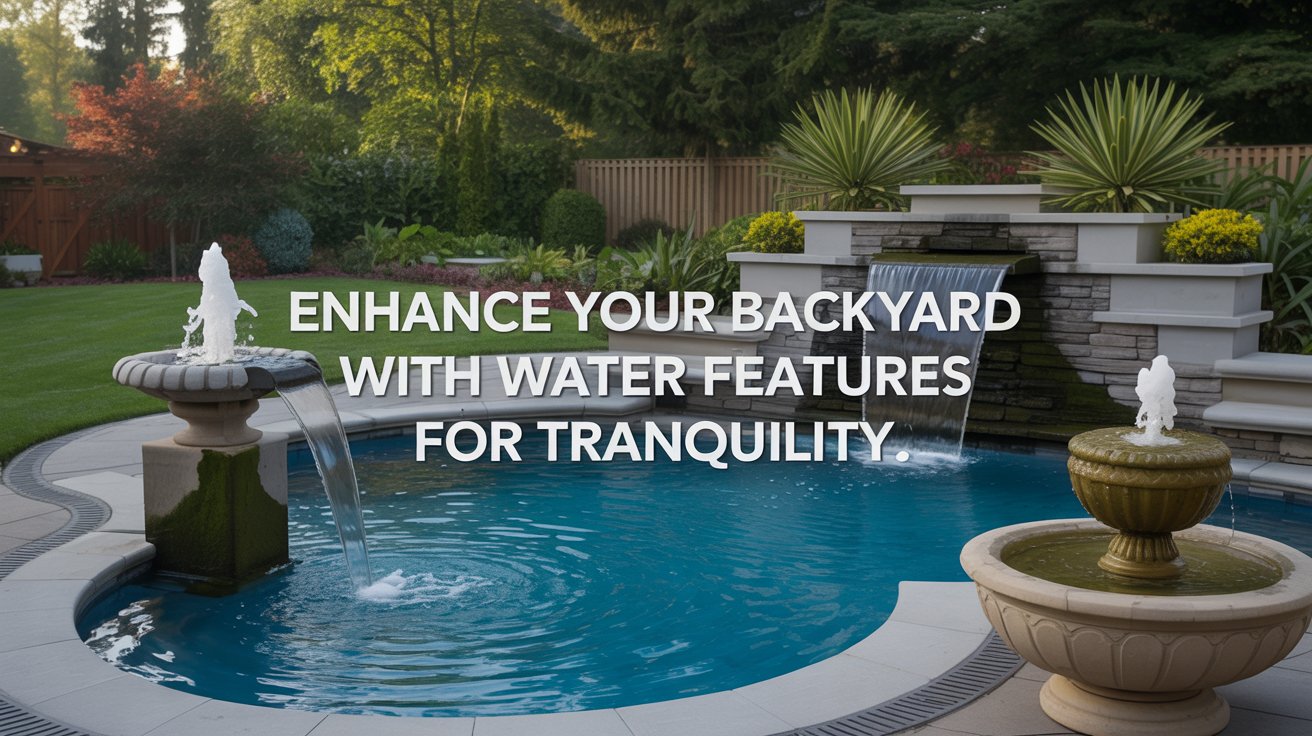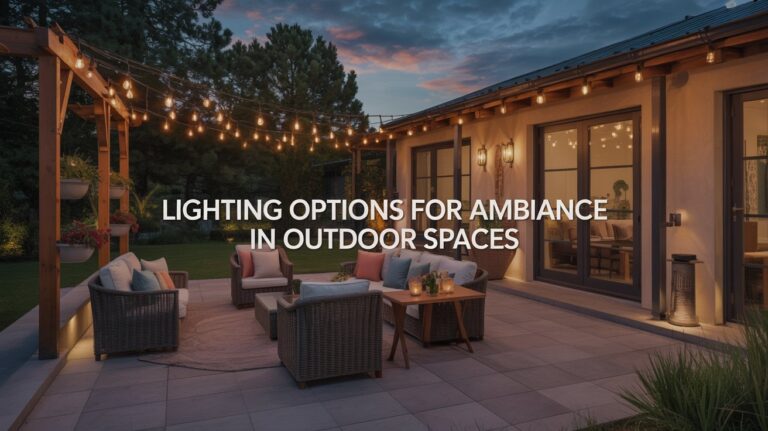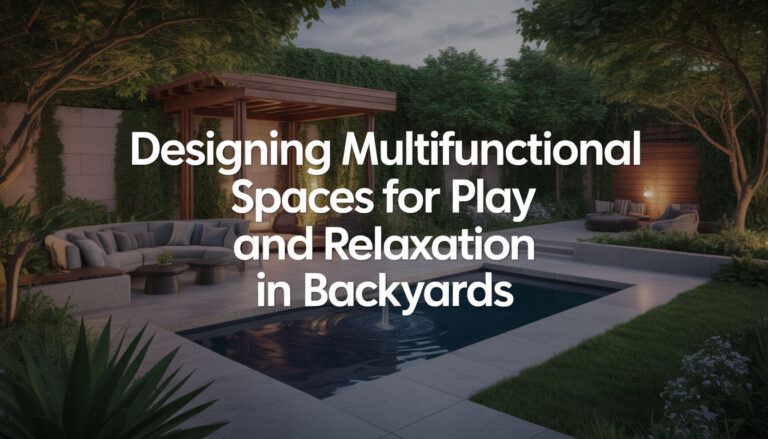How to Enhance Your Backyard With Water Features for Tranquility
I have been, or can be if you click on a link and make a purchase, compensated via a cash payment, gift, or something else of value for writing this post. As an Amazon Associate, I earn from qualifying purchases. Please read my full Affiliate Disclosure for more information.
To enhance your backyard with tranquility, start by selecting a water feature that suits your space, climate, and aesthetic—fountain, waterfall, or pool—and plan a layout that guides sightlines and zones for calm, clutter-free movement. Pair soft lighting (2700–3000K) with durable materials and cohesive finishes to highlight textures and reflections. Balance sound with adjustable flow, place plants for habitat, and keep maintenance routines simple. With thoughtful placement and care, serenity becomes a repeatable, enduring feature you’ll appreciate even more as you explore further.
Key Takeaways
- Choose a water feature (fountain, waterfall, or pool) that fits your space, climate, and maintenance preferences for calm visuals and sound.
- Plan layout and sightlines to guide movement, add focal points, and ensure seating and viewing areas remain serene.
- Use soft, layered lighting (2700–3000K) and weatherproof fixtures to extend tranquility after dark without glare.
- Optimize acoustics with adjustable flow, baffles, and proper placement to create a balanced, peaceful soundscape.
- Integrate plants and wildlife habitats, maintain good water quality, and perform routine maintenance for lasting serenity.
Choosing the Right Water Feature for Your Space
Choosing the right water feature begins with your space, climate, and how you want to interact with it. You assess scale, sun exposure, and noise tolerance to determine form and maintenance needs. Consider garden aesthetics and how a feature complements existing plantings, hardscape, and sightlines. The placement decision hinges on viewing angles, drainage, and proximity to utilities, ensuring safe, accessible operation. Material and pump efficiency influence long-term costs and reliability. Decide between a discreet fountain, a dramatic waterfall, or a reflective pool, aligning function with visual impact. Ultimately, water feature placement and style should enhance tranquility while meeting practical constraints.

Planning Your Layout for Calm and Flow
To plan a layout that promotes calm and flow, begin by mapping paths and sightlines to guide movement and sight without abrupt stops. You’ll align zones so circulation feels natural, avoiding clutter and dead ends. Consider focal points such as a tranquil fountain, a seating alcove, and a viewing platform, integrated with plant textures that soften edges. Position garden furniture to encourage lingering rather than crowding; guarantee sightlines remain uninterrupted from entry to main features. Account for outdoor heating in cool seasons, placing benches near warm zones. Maintain scale consistency, use permeable materials, and preserve quiet contrasts between water, stone, and greenery.
Soundscapes: Selecting Features by Audible Mood
Sound is the guiding thread in backyard water features, shaping mood as much as form. You’ll tune soundscapes by selecting features that match an audible mood, prioritizing clarity and balance. Focus on sound quality through directed flow, damping where needed, and spatial layering to avoid masking cues. Acoustic customization lets you adjust reverb, tonal range, and reach, ensuring each element contributes to serenity rather than noise.
- Choose feature placement that preserves clarity and avoids competing tones
- Use adjustable flow controls to sculpt midrange and bass
- Employ strategic baffles or diffusers to refine reverberation and gain
This precise approach sustains calm, intelligible soundscapes.
Materials and Styles to Match Your Garden
Your water feature should pair materials with your garden’s structure, balancing weight, texture, and color for cohesive perception. Consider a Material Pairings Guide that aligns stone, metal, and wood with surrounding plantings, ensuring durability and visual rhythm. Style-Compatible Finishes then refine the look—polished, matte, or rustic—so every element reads as one integrated system.
Material Pairings Guide
Choosing the right material pairings for a backyard water feature hinges on how textures, colors, and durability interact with your garden’s scale and climate; matching stone or concrete with metals, tiles, or wood creates a cohesive, low-maintenance display that ages gracefully.
Material pairings guide your sense of balance, rhythm, and longevity. The goal is to harmonize form and function while supporting garden furniture placement and decorative accents.
- Combine natural stone with brushed metal for contemporary texture
- Use ceramic tiles to frame basins and invite reflections
- Integrate teak or cedar outdoors for durable contrast with stone
Style-Compatible Finishes
To achieve a cohesive garden aesthetic, match finishes to both the surrounding materials and the overall style you’re aiming for. You’ll align textures, colors, and patinas across elements so water features read as an extension of the landscape. Choose finishes that mirror adjacent pavements, cladding, or soil tones; avoid clashes that shout artificiality. Consider tonal harmony, not uniform sameness, and select materials capable of weathering your climate. Integrate garden furniture with complementary finishes for unity, then employ landscape lighting to sculpt silhouettes and reflect surfaces. Precision in detail guarantees calm, legible passages from water to garden.
Lighting Tips to Extend Tranquility After Dark
You’ll fine-tune your night scene with soft glow options that highlight water textures while keeping glare to a minimum. Consider pathway lighting that guides movement and frames features without overpowering tranquility, and pair it with practical safety night practices to prevent missteps. This opening discussion sets the stage for selecting materials, placement, and controls that balance aesthetics with function.
Soft Glow Options
Soft glow lighting can transform a backyard water feature from a daytime delight into a tranquil nighttime focal point, emphasizing contours, movement, and reflection without overpowering the scene. You’ll optimize subtle illumination by selecting low-output sources and placing fixtures to reveal textures without glare. Solar lighting offers energy-efficient options for general ambient glow, while decorative accents highlight key architectural details and plant silhouettes. Use color temperature between 2700K and 3000K to maintain natural warmth. Balance brightness with shadows to preserve depth and motion in water.
- solar lighting integration for efficiency and ease
- decorative accents to frame focal points
- color temperature and contrast for mood consistency
Pathway Lighting Tips
Pathway lighting should guide movement while preserving the garden’s nocturnal calm, so opt for low-profile fixtures that gently illuminate steps, edges, and shifts without creating glare. You’ll benefit from a layered approach: low bollards at intervals, recessed ground lights along walk lines, and indirect uplights to sculpt tree canopies. Aim for a color temperature around 2700–3000K to sustain warm, natural tones. Use shading and diffusers to minimize hotspots, ensuring consistent luminance along the path. This garden lighting enhances safety while maintaining outdoor ambiance, coordinating with water features rather than competing with them. Balance brightness with contrast to preserve tranquil nighttime enjoyment.
Safety Night Practices
To extend tranquility after dark, implement safety-focused lighting practices that emphasize clear pathways, monitored zones, and unobtrusive illumination. You’ll balance aesthetics with function, using nighttime illumination that guides without glare. Position lamps to illuminate steps, edges, and water features, while avoiding reflections that disturb calm. Establish safety barriers where drops or equipment exist, and ensure cords and electrical components are weatherproof and hidden. Dimmed, color-stable lighting preserves mood and visibility. Regularly inspect fixtures and seals, replacing worn parts before failure. Maintain zones that are illuminated for safety but quiet for contemplation.
- Highlighted pathways reduce tripping risk with consistent luminance
- Clear safety barriers deter access to hazards
- Low-glare, warm-toned fixtures preserve ambiance
Low-Maintenance Options for Busy Lifestyles
For busy households, low-maintenance water features deliver steady enjoyment with minimal upkeep, thanks to streamlined design, durable materials, and integrated automation. You’ll appreciate modular components that simplify installation and service, plus sensors that optimize pump speeds and filtration. Choose compact water sculptures and quiet liners to minimize noise and evaporation losses, while preserving visual drama. Aquatic plants can be selected for low-maintenance vigor, requiring modest pruning and seasonal feeding. Routine checks remain brief yet effective, ensuring consistent clarity and safe operation. This approach harmonizes aesthetics with practicality, offering tranquil, reliable scenery without demanding daily attention from you.
Integrating Plants and Wildlife With Water Features
Incorporating plants and wildlife into water features blends ecological function with visual appeal, enriching both habitat value and daily enjoyment. You’ll balance plant integration with habitat needs, selecting species that tolerate moisture and provide cover, nectar, or spawning sites. Choose native plants to support local wildlife and reduce maintenance, and position emergent vegetation where it enhances filtration and shading. Design hydrology to minimize stagnation, promoting safe wildlife passage and stable microhabitats. Consider biodiversity by mixing floating, submerged, and marginal plants.
- Native plant integration supports wildlife habitat and resilience
- Strategic shading and filtration enhance water quality
- Varied vegetation stages attract diverse species
Maintenance Routines for Long-Lasting Serene Water Features
Regular upkeep is essential to keep serene water features pristine and inviting, balancing mechanical reliability with aesthetic quietude. You’ll adopt a concise schedule: daily visual checks, weekly debris removal, monthly filter cleaning, and quarterly system audits. Prioritize water quality by testing pH, hardness, and chlorination levels, adjusting as needed to protect clarity and aquatic life. Maintain pump maintenance routines—inspect seals, verify proper prime, and monitor vibration for longevity. Keep electrical connections dry and secure, and document all fixes. Seasonal turnover should include cleaning the liner, inspecting fittings for wear, and calibrating flow rates. With disciplined care, serenity remains uninterrupted.
Conclusion
You’ll finish with a water feature that’s both technically sound and aesthetically serene. By choosing the right element, planning flow, and tuning sound, you create a calm microclimate that’s easy to maintain. Match materials to your garden’s character, employ subtle lighting, and opt for low-maintenance options to preserve tranquility. Integrate strategic plantings to support wildlife, and establish simple routines for ongoing care. Your landscape will deliver lasting serenity, harmony, and a quietly refined sense of place.






